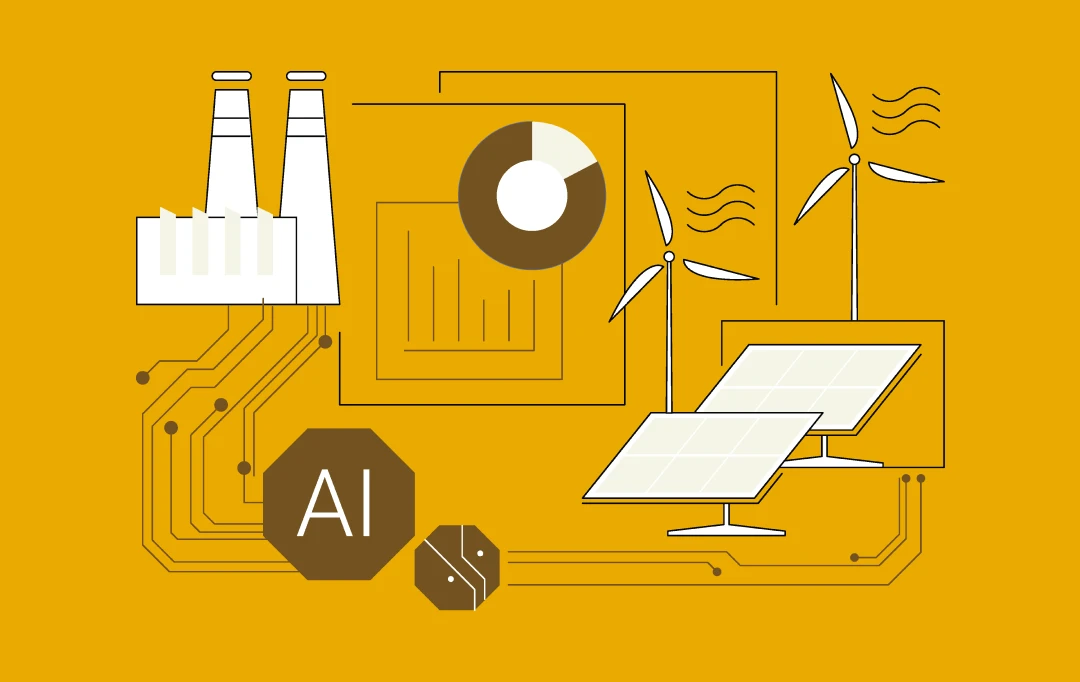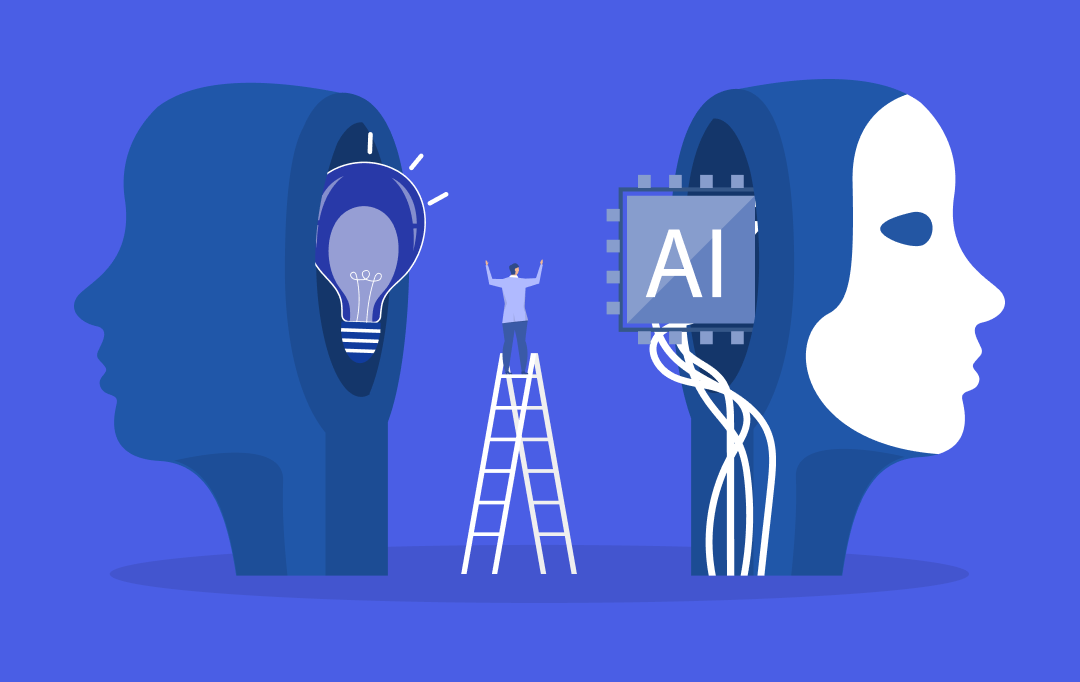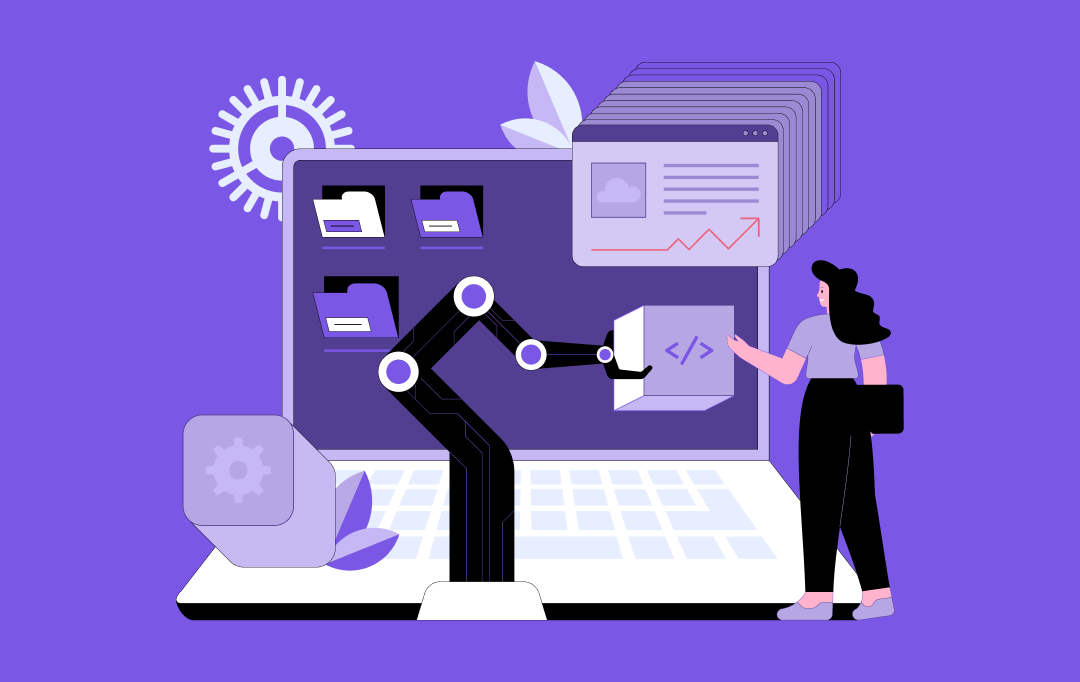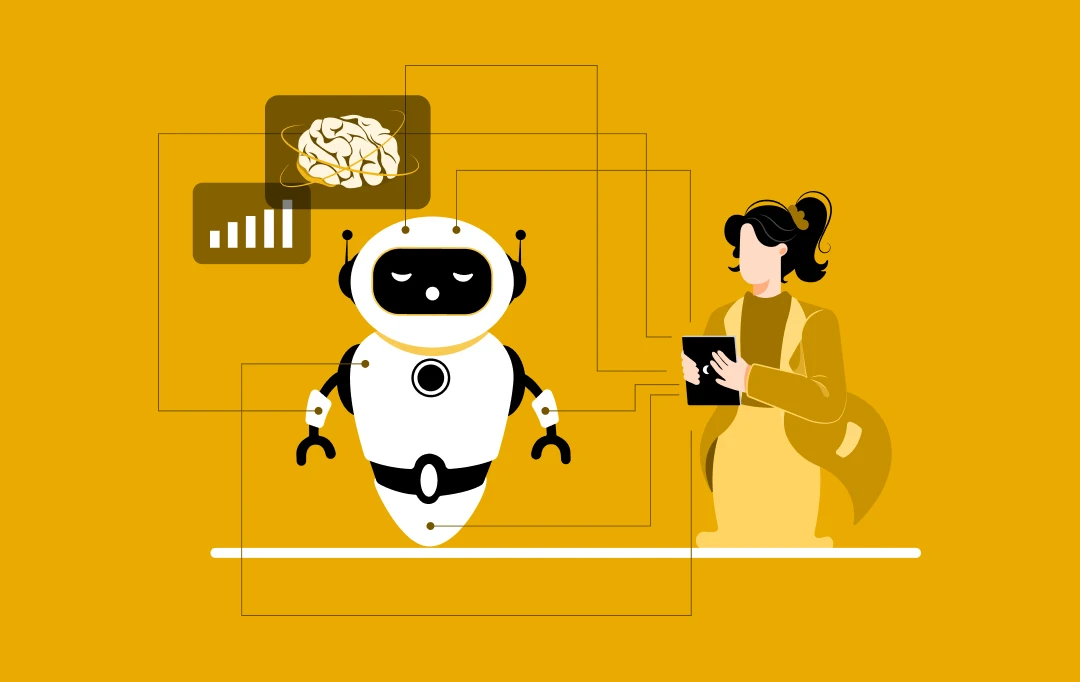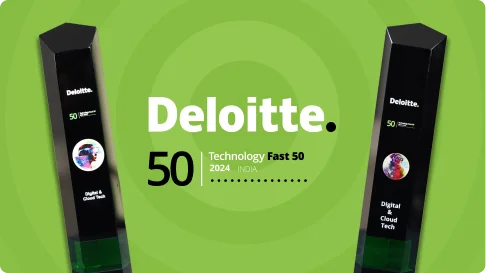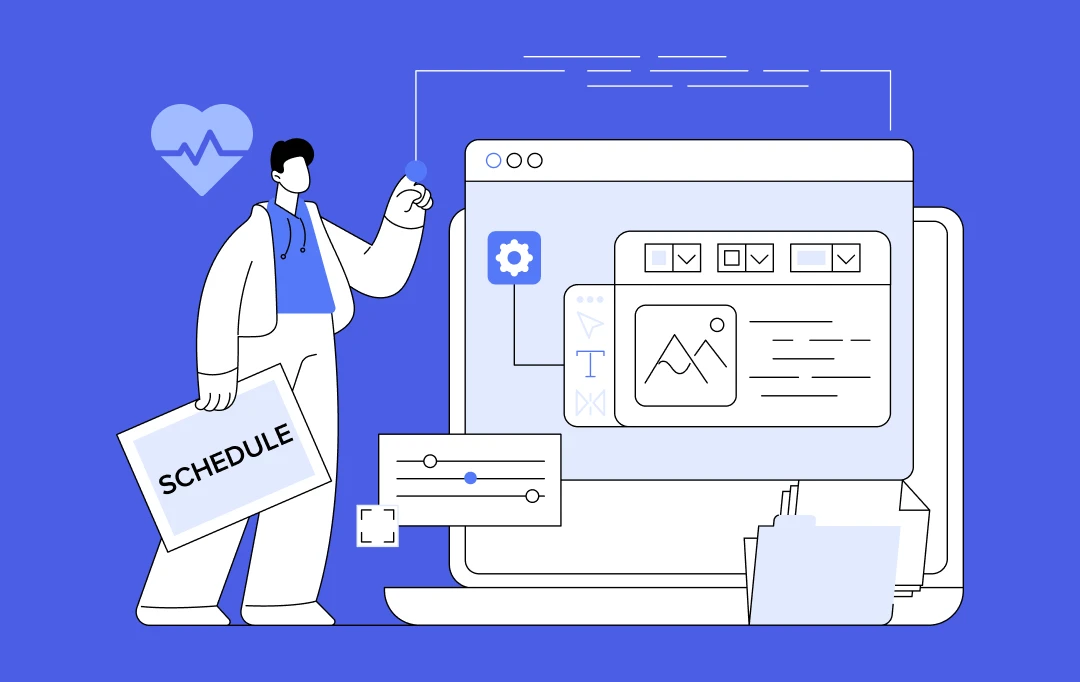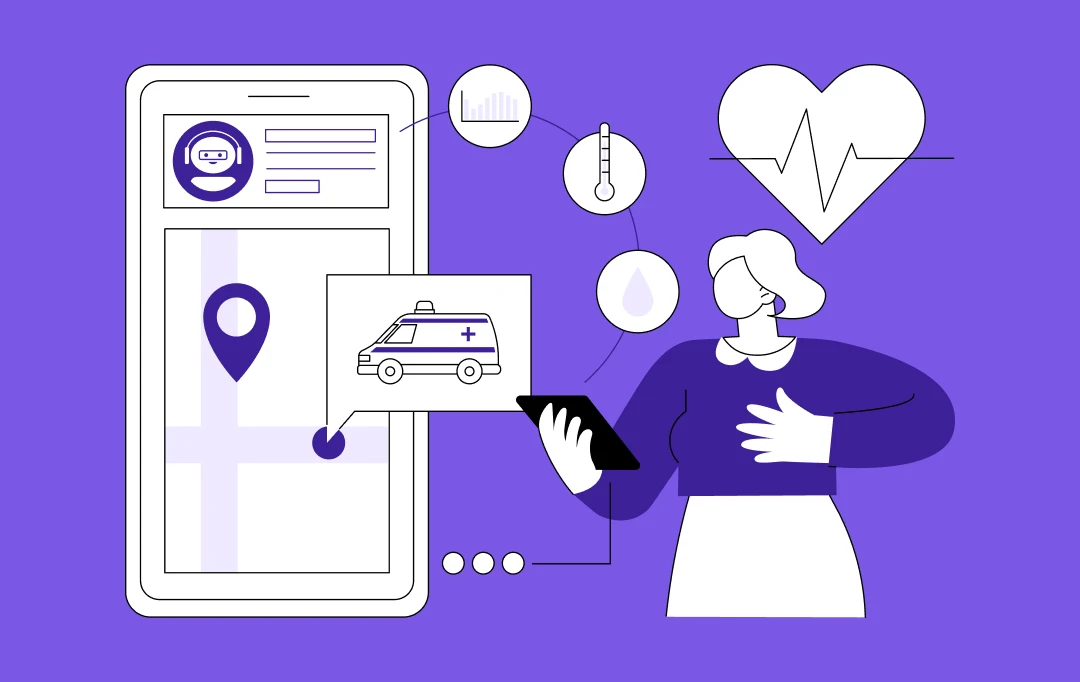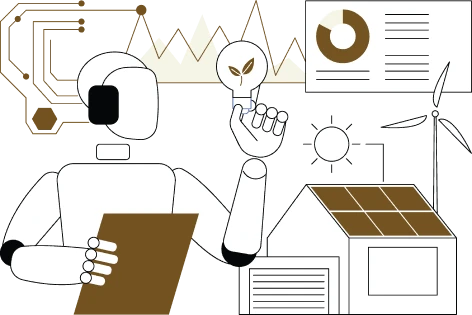- How Does AI in Sustainability Work?
- Understanding the Different Types of AI Technologies Driving Sustainability
- Machine Learning (ML)
- Computer Vision
- Green AI
- Responsible AI
- Natural Language Processing (NLP)
- Generative AI (GenAI)
- Reinforcement Learning (RL)
- Benefits of AI in Sustainability
- Cost Savings and Operational Efficiency
- Adherence to the Environmental Regulations
- Enhanced Brand Image and Consumer Loyalty
- Scalability of Sustainability Initiatives
- Greater Innovation
- Key Use Cases and Examples of AI in Sustainability
- Energy Efficiency and Optimization
- Waste Reduction and Recycling
- Supply Chain Sustainability
- Carbon Footprint Analysis and Reduction
- Predictive Analytics for Resource Management
- AI in Sustainable Packaging
- What Are the Key Steps for AI in Sustainability?
- Define Clear Sustainability Goals
- Evaluating the Correct AI Technologies
- Assure Data Accessibility and Integrity
- Fostering Internal Collaboration
- Employ AI for Real-Time Reporting and Monitoring
- Environmental Impact Assessment for Auditing Emissions
- Challenges and Opportunities in AI in Sustainability
- Data Availability and Quality
- Initial Outlay and Cost of Infrastructure
- Incorporation with Existing Systems
- Regulatory and Ethical Issues
- Scalability and Adaptation
- Why Appinventiv for AI-Driven Sustainability Solutions?
- FAQs
Key takeaways:
- Sustainable companies are increasingly turning to AI, which is now essential to make facilities energy efficient and monitor emissions.
- It drives major sustainability initiatives, such as climate action and energy optimization, and has translational implications in terms of disaster forecasting and supply chain optimization.
- Among the major AI technologies are ML, Computer Vision, and NLP that help optimize resources, minimize wastage, and monitor the environmental effects in real-time.
- By achieving the sustainability targets, AI assists companies to cut down expenses, enhance functions, and foster brand loyalty.
- Nevertheless, the quality and cost of data are challenges of AI implementation, but its flexibility, as well as scalability, can support sustainable success in the long run with planned implementation.
AI has quickly become essential for corporate sustainability efforts, moving well beyond simple reporting into actual operational improvements. For instance, Google is now offering a unique opportunity to contribute to the shift toward a more sustainable future by investing in AI technologies.
This will enable people, cities, and other partners to collectively reduce their carbon equivalent emissions by a gigaton every year by 2030. The tech behemoth is also pursuing a bold goal to reach net-zero emissions across its operations and value chain by 2030, including running its data centers and campuses on 24/7 carbon-free energy (Source: Google).
This shift extends far beyond tech giants. Research from IBM reveals that by 2025, 77% of CEOs leading transformational sustainability efforts anticipate that workflows across their organizations will be digitized and powered by AI-driven automation. Also, GenAI will significantly improve ESG reporting accuracy while accelerating decarbonization timelines.
The implications are straightforward: AI has evolved from a business advantage to a fundamental requirement for organizations pursuing resilient, net-zero operations. Companies serious about long-term sustainability can no longer treat AI integration as optional—it’s become a competitive necessity.
Achieving AI in sustainability requires a strategic blend of the right technologies, clear environmental objectives, quality data, and cross-functional collaboration to drive measurable and lasting impact.
In this blog, we’ll explore how businesses can leverage various AI technologies to achieve their sustainability goals. From understanding the different types of AI and their practical benefits to examining real-world use cases, key implementation steps, and the challenges and opportunities that come with adoption—we’ll break down everything you need to know to integrate AI into your sustainability strategy. Let’s dive in.
Don’t fall behind; discover how AI can elevate your reporting and results
How Does AI in Sustainability Work?
AI in sustainability operates as a sophisticated data collection and analysis system that helps companies make smarter environmental decisions. It pulls together information from satellite imagery, IoT sensors, supply chain data, and emissions tracking to create a comprehensive picture.
What makes AI sustainability powerful is its ability to forecast environmental impacts, identify inefficiencies, and test different sustainability scenarios before companies commit resources. Businesses can anticipate changes rather than just react to them—whether that’s optimizing energy consumption, reducing waste streams, or adjusting operations to minimize environmental damage. Instead of static reporting tools, you get intelligence that adapts in real-time as conditions change.
McKinsey’s analysis found that AI for sustainability already touches all 17 UN Sustainable Development Goals (SDGs). The technology shows the strongest results in climate action (SDG 13), clean energy (SDG 7), sustainable cities (SDG 11), and responsible consumption (SDG 12).

Out of 600+ use cases they examined, over 160 focused specifically on climate and environmental sustainability. These aren’t experimental projects anymore. Companies have moved many solutions into full operation, particularly for natural disaster forecasting, biodiversity monitoring, and energy grid optimization. AI Sustainability helps organizations handle complexity at scale, becoming a genuine catalyst for measurable progress toward global sustainability targets.
Understanding the Different Types of AI Technologies Driving Sustainability
AI isn’t a single entity—it’s actually several specialized technologies that address environmental problems in different ways. Companies are discovering that from reducing energy waste to improving ESG transparency, these various approaches help turn sustainability aspirations into measurable outcomes. Here’s what each type brings to the table for building greener, more resilient operations.
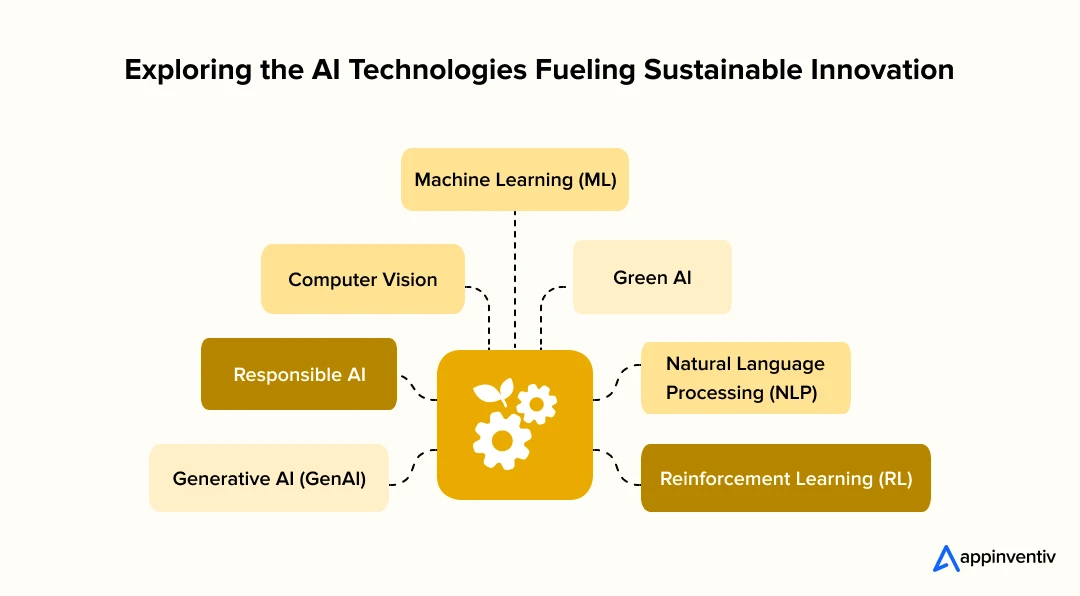
Machine Learning (ML)
Machine learning algorithms anchor most sustainable AI efforts today. It processes massive amounts of data—everything from emissions logs to energy usage patterns and climate variables, then identifies trends and forecasts what’s likely to happen next. Companies use ML to streamline supply chains, boost grid efficiency, and develop smarter carbon reduction plans.
Computer Vision
Computer vision lets machines interpret visual data from satellites, drones, and sensors on the ground. The connection between sustainability and AI becomes obvious here; this technology tracks deforestation as it happens, spots pollution sources, monitors crop conditions, and measures coastal erosion. It handles environmental oversight at scales that would be impossible with human teams alone.
Green AI
Green AI centers on minimizing the environmental impact of artificial intelligence itself by promoting energy-efficient models, sustainable computing practices, and low-carbon infrastructure. It emphasizes optimizing algorithms and systems to reduce resource consumption without sacrificing performance. In sustainability-driven initiatives, Green AI ensures that the technologies designed to combat climate change do not inadvertently contribute to it.
Responsible AI
Responsible AI principles make sure sustainability applications stay transparent, ethical, and focused on long-term results. For instance, companies like EY follow the responsible AI framework that drives their sustainability AI ecosystem and core principles.
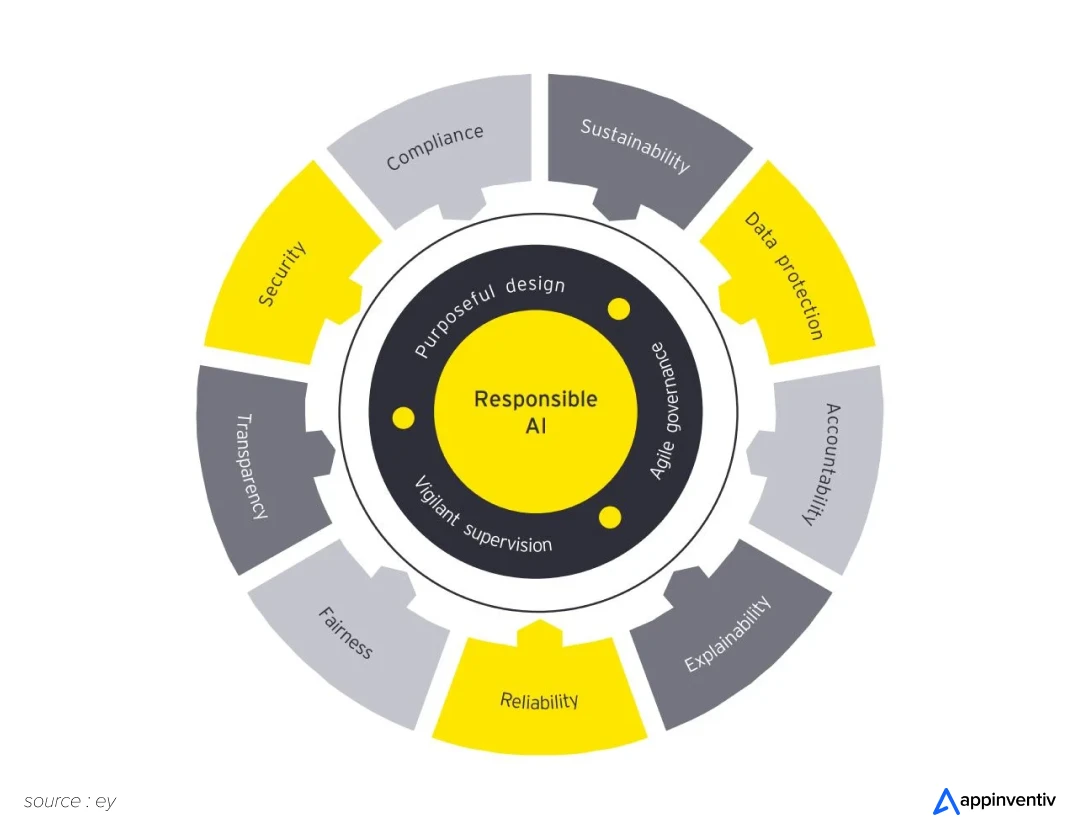
They weave sustainability thinking into every phase of AI development, purchasing, and deployment. Whether for internal operations or client work, this framework ensures that AI supports environmental objectives without compromising ethics or accountability.
Natural Language Processing (NLP)
NLP helps organizations digest complex, unstructured information from AI regulation in sustainability, ESG documents, and research studies. Where AI and sustainability intersect most clearly is in how NLP automates compliance tasks and simplifies reporting by extracting important metrics from thousands of documents that would otherwise require months of manual review.
Also Read: NLP applications and their use cases for modern enterprises
Generative AI (GenAI)
Generative AI creates simulations for low-carbon product designs, produces sustainability reports, and models future environmental scenarios. Capgemini’s findings show that artificial intelligence and sustainability work especially well in GenAI applications, which accelerate ESG processes and help teams explore fresh solutions to climate problems.
Reinforcement Learning (RL)
RL excels in dynamic environments—smart grids, urban traffic networks, and manufacturing systems. With frameworks like the EU AI Act influencing deployment strategies, RL keeps learning from real-time feedback to balance renewable energy sources, optimize consumption patterns, and reduce fuel use in transportation and logistics.
Benefits of AI in Sustainability
AI helps businesses use resources better, cut down on waste, and reduce their environmental impact while making operations run smoother. By using data insights, companies can make smarter, eco-friendly choices that work for both the planet and their bottom line. Here are some of the benefits of investing in AI sustainability:

Cost Savings and Operational Efficiency
AI is a great solution for those companies that want to reduce costs and simplify their businesses, and increase their sustainability efforts. AI provides economic and environmental benefits to users by maximizing output per unit of input, automating processes, and reducing waste.
As an example, the use of AI will help to consume energy more efficiently, better monitor the current stocks, and automate garbage collection, which has a direct impact on the decrease in costs. With AI in business, companies can look forward to increased efficiency in diverse departments, such as production and supply chain management, which will ultimately have a positive impact on their bottom line.
Adherence to the Environmental Regulations
With environmental regulations becoming increasingly complex, AI has helped businesses stay compliant with the rules. The constantly changing rules, such as the EU AI Act, EU Carbon Tax, or the EPA requirements, will be something that AI can significantly improve on without the need of a person to supervise everything.
With AI, it is not only possible to automate reporting and monitor emissions, but also to track environmental impact and predict how regulatory landscapes may evolve in the future. Such proactivity is one way to ensure that companies not only abide by the current set of regulations but also are prepared to adhere to those in the future, thereby minimizing the risk of fines or negative publicity.
Enhanced Brand Image and Consumer Loyalty
In the current marketplace, customers are increasingly educated and considerate of the environmental effects of the products and services that they purchase. AI-fueled sustainability initiatives can aid businesses in keeping up with the increasing customer demand for sustainable and environmentally friendly practices.
From clear carbon tracking to supply chains optimized with fewer environmental footprints, AI can aid businesses in boosting brand reputation. With consumers increasingly preferring to choose brands that share their values, businesses utilizing AI to enhance their sustainability will not only appeal to consumers with environmental concerns but also build stronger, more loyal customer bases.
Scalability of Sustainability Initiatives
AI empowers businesses to efficiently take sustainability initiatives to scale within regional locations and operations. With growth, keeping environmental performance uniform gets sophisticated—AI facilitates process standardization and automation such as supply chain management, waste minimization, and energy consumption. This fosters global replication of best-practice sustainability initiatives, driving growth while holding environmental objectives intact.
Greater Innovation
AI isn’t just making things efficient and compliant, but creating new ideas and innovations as well. If businesses invest in AI-powered sustainability, they will discover new business models and sustainable, profitable services. Firstly, AI can be used to develop green fintech innovations, where financial products and financial services are designed to empower sustainable businesses.
Similarly, artificial intelligence can catalyze product lines around energy efficiency or optimize the circular pattern of the economy for various sectors. AI can open up altogether new markets and possibilities for those enterprises that are adventurous enough to move into the realm of sustainability.
Key Use Cases and Examples of AI in Sustainability
AI is already having real-life effects in different industries, helping them work smarter and more sustainably. Optimizing resource use, facilitating predictive climate models, and other applications are areas where artificial intelligence is being leveraged to meet environmental and business objectives. Here are some of the top use cases of AI for sustainability with real-life examples:

Energy Efficiency and Optimization
Real-time data and predictive modeling have completely changed how companies handle energy management. The sustainability AI ecosystem begins with smart sensors and analytics platforms that work with what companies already have, letting models predict energy needs and adjust usage automatically.
Google’s data centers show this perfectly—their algorithms adjust cooling based on real conditions and cut energy use by 40%. That’s serious cost savings plus a much smaller carbon footprint.
Waste Reduction and Recycling
Waste management got much better through improved sorting, higher recycling rates, and less environmental waste overall. These sustainable AI solutions handle massive data volumes instantly, optimizing waste operations at scales we couldn’t reach before.
Companies need IoT-powered smart bins and logistics platforms that track waste and optimize collection routes with real-time analytics.
Rubicon Global proves this works. They analyze live data so trucks take efficient paths, cutting fuel use and emissions while keeping operations profitable and environmentally sound.
Supply Chain Sustainability
Supply chains are getting smarter and more transparent through better operations, emissions tracking, and waste reduction opportunities. Companies use AI for sustainability applications to build genuinely sustainable supply chains.
Start with AI-powered analytics that monitor energy and emissions from sourcing to distribution, then identify where you can cut carbon and minimize waste.
Unilever tracks carbon emissions across its entire supply chain, analyzing supplier data to make better sourcing choices that actually reduce carbon output. They’re working toward net-zero by 2039 using these data insights.
Carbon Footprint Analysis and Reduction
Measuring carbon footprints became more useful through better insights that cut emissions and hit sustainability targets. AI sustainability tools check environmental impact across operations so companies can make smarter long-term decisions.
Get AI-powered carbon management platforms that track emissions across everything—production, logistics, the works. Real-time visibility helps you stay on track with sustainability goals.
Microsoft tracks its carbon emissions with continuous data analysis, monitoring operations to move toward carbon-negative status by 2030. Their method shows how data insights cut environmental impact while meeting corporate objectives.
Predictive Analytics for Resource Management
Resource management has evolved through improved demand forecasting, water optimization, and waste reduction across various industries. These sustainable AI methods help businesses use resources efficiently while saving water, energy, and raw materials.
Use predictive analytics tools that study past consumption and forecast future needs. Predict energy peaks or agricultural water requirements to manage resources ahead of time.
IBM’s Green Horizons platform predicts pollution and optimizes urban energy use. They analyze sensor data and historical patterns to help cities cut energy consumption, improve air quality, and reach sustainability targets.
AI in Sustainable Packaging
Machine learning, analytics, and real-time data cut packaging’s environmental impact while boosting efficiency. These sustainability AI ecosystem tools optimize materials and reduce waste throughout packaging cycles, predicting environmental effects so businesses can pick sustainable options.
Combine AI with supply chain data to find lightweight packaging opportunities that use fewer resources without compromising protection.
Nestlé uses these methods to improve packaging sustainability. IBM’s solutions help them design packaging that cuts waste and optimizes materials, exploring ways to reduce environmental impact through better materials and recyclability.
What Are the Key Steps for AI in Sustainability?
You can change sustainability with AI—given that you build the right foundation. The following are significant steps to align technology with your environmental targets for sustainable long-term development and scalable impact.
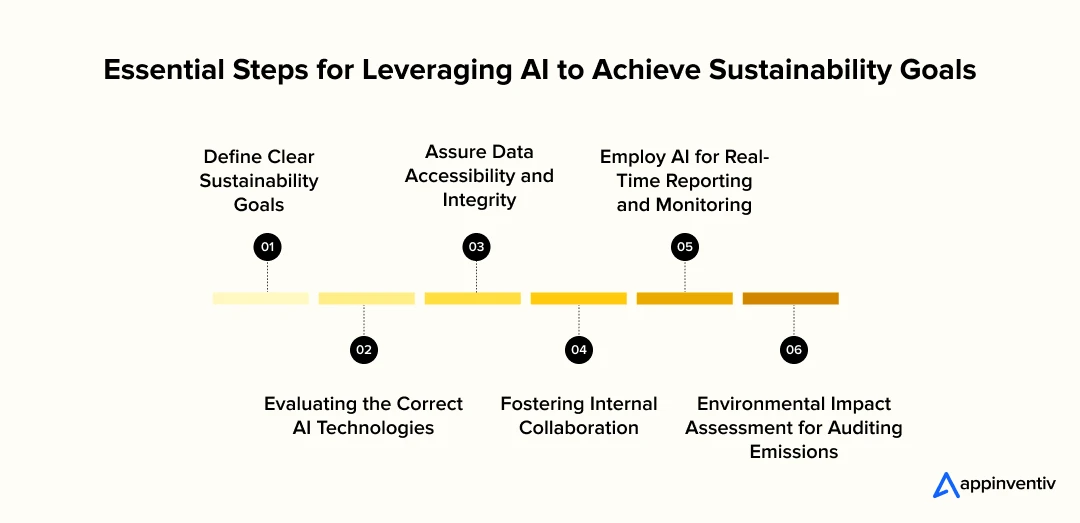
Define Clear Sustainability Goals
Start with specific and measurable sustainability objectives that will help guide your AI adoption process. They could include targets to reduce carbon output, to make water usage more efficient, or to reduce resource consumption across operations.
Well-defined objectives make sure that AI projects are strongly connected to the company’s long-term environmental goals, providing direction and focus to strategy and tactical choices.
Evaluating the Correct AI Technologies
Evaluate AI solutions and instruments that are most compatible with your sustainability targets. Whether predictive analytics to handle resources or AI-enabled energy optimization, the technology implemented must address unique business challenges.
Those with products that can be integrated with existing systems and those that can adapt and scale with growing sustainability programs must be considered. Strategic evaluation will allow you to select the most compatible AI solutions to track environmental footprint, improve operations efficiency, and reduce waste.
Assure Data Accessibility and Integrity
Data is central to all AI projects, and AI effectiveness in sustainability is directly reliant on data quality and availability. Invest in IoT sensors, cloud data platforms, and AI analytics programs to extract real-time data regarding energy consumption, water usage, and waste management.
With accurate and high-quality data, AI can make very accurate predictions, helping firms streamline resource management and make proactive decisions to minimize waste, conserve energy, and monitor environmental effects in the long run.
Fostering Internal Collaboration
To sustain AI projects at an entire company level, foster cross-functional collaboration between technology and operations teams. The top management should consider embedding sustainability as part of the company’s strategy, whereby AI implementation becomes everyone’s shared goal within all departments.
Achieving this alignment enables AI solutions to address sustainability challenges while fostering a culture of responsibility and innovation within the company.
Employ AI for Real-Time Reporting and Monitoring
Artificial-intelligence platforms enable businesses to monitor environmental data in real time. The software tracks carbon footprints, energy consumption, water intake, and departmental performance efficiency, providing real-time feedback to adjust strategies accordingly.
Environmental Impact Assessment for Auditing Emissions
In order to genuinely comprehend your company’s environmental footprint, conduct Environmental Impact Assessments (EIA) that utilize AI to monitor and predict carbon emissions, energy usage, and water consumption. AI is able to identify hotspots where there are higher-than-expected emissions or consumption of resources, so that companies can concentrate their improvement initiatives there
Continuous evaluation ensures that AI-related projects continue to sustain carbon minimisation, water conservation, and energy efficiency, and that businesses can meet their sustainability objectives.
Let our experts help you implement the key steps to successfully integrate AI into your environmental strategy and drive long-term impact
Challenges and Opportunities in AI in Sustainability
Implementing AI for sustainability has a series of benefits and opportunities, but it also comes with challenges. Understanding these barriers is the key to leveraging the full potential of AI in your sustainable business processes. Let’s have a look at some of the pressing obstacles and how to resolve those:
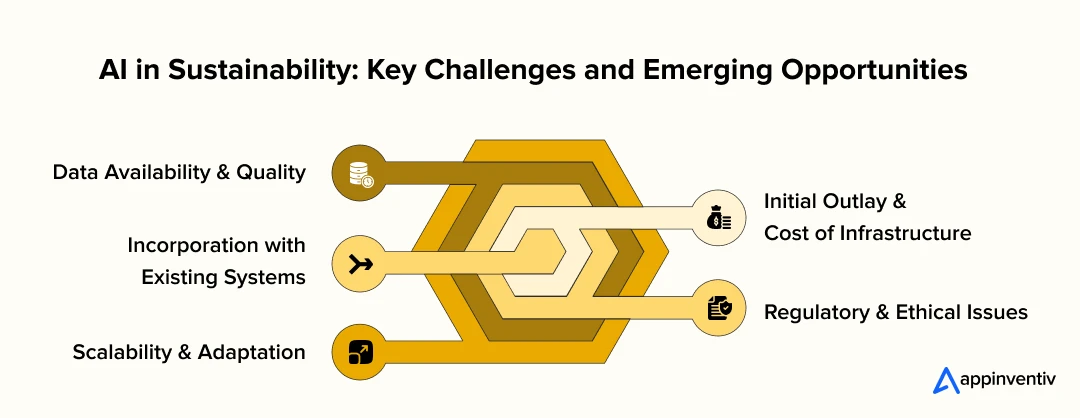
Data Availability and Quality
One of the biggest challenges to applying AI to sustainable activities is acquiring accurate and reliable data. Most industries, especially those with limited data sources or disjointed data sets, struggle to maintain data quality that can be used to train AI systems.
Algorithms are hungry for big data—data that must be stable, clean, and representative of real-world environments. With weak data, AI will produce biased results, and poor decisions will be made that can derail your sustainability programs. The sense of urgency surrounding improved data collection infrastructure and data standardization is therefore critical to unleashing AI’s full potential for achieving sustainability.
Initial Outlay and Cost of Infrastructure
Even though AI-driven products can deliver lasting long-term savings, initial investments to fund technology, infrastructure, and skilled personnel can discourage most businesses. For example, initial investments to introduce AI-enabled platforms, replacement of outdated systems, or training personnel to understand and exploit new technology can be significant.
However, businesses need to view this initial investment as a long-term strategic opportunity rather than just an expense. With clearly specified ROI requirements and a phased implementation strategy, businesses can make the monetary investment acceptable while retaining the benefits of AI-enabled sustainability.
Incorporation with Existing Systems
Most firms, especially those that are involved with traditional or non-core businesses, have discovered that applying AI solutions to existing systems is not very easy. Legacy programs and outdated systems may hinder the connection of AI with workflows, supply systems, or data management systems.
Such intricacy can slow down the implementation process, increase costs, and create resistance to change within an organization. Precise planning, module integrations, and selecting AI solutions with compatible systems, however, can make this process efficient and integrate AI seamlessly within your existing tech stack.
Regulatory and Ethical Issues
Implementation of AI for sustainable activities will have to balance regulatory as well as ethical concerns equally. As companies strive to comply with global sustainability policies, such as the EU Carbon Tax or EPA regulations, they will need to ensure that not only are their AI systems efficient, but also that these systems are transparent, interpretable, and eco-friendly.
Moral concerns with AI decisions—such as biasing or lack of accountability—should also be considered. Firms ought to prioritize creating AI programs that are auditable and can document ethical decision-making, especially when handling sensitive environmental data.
Scalability and Adaptation
Scaling up AI-enabled sustainability initiatives is also a challenge as businesses grow and their own sustainability goals shift. What scales at a narrow scope will not automatically translate as easily when a business is growing geographically or diversifying operations. Making AI-enabled systems flexible enough to adapt to shifting business needs will still be important to longer-term success.
As organizational complexity increases, the scalability of the AI solution becomes critical. A solution that can be implemented within one region or one function will need to be scalable throughout the company, to improve sustainability initiatives continuously, and to adapt as new regulations, new technologies, and new business models are added.
Why Appinventiv for AI-Driven Sustainability Solutions?
At Appinventiv, we don’t just deliver AI solutions but transformational AI-enabled sustainable solutions that help businesses achieve their sustainability targets with precision, efficiency, and lasting impact. With years of success in delivering innovative AI solutions for sectors, we are your most competent collaborator to overcome challenges as well as opportunities of sustainability.
- Deeper Understanding of AI and Sustainability
As an AI development services company, Appinventiv blends innovative machine learning, predictive analytics, and IoT integration to provide AI solutions that suit your sustainability targets. Whether it is energy efficiency, carbon monitoring, or waste management, we create solutions that suit your environmental as well as business targets. - Bespoke Solutions to Suit Your Unique Sustainability Needs
At Appinventiv, we recognize that there is no one-size-fits-all solution to business. That’s why we build customized AI solutions to meet your specific needs, so that you can reduce emissions, best utilize resources, and maximize efficiency while achieving solid sustainability outcomes. We do not sell off-the-rack products; we deliver products that fit with your operations without a glitch, to make sustainable differences stick. - Established Success with International Brands
Appinventiv has successfully deployed multiple AI-powered projects for leading enterprises like KFC, Pizza Hut, and Domino’s to optimize operations and maximize sustainability programs. With a results-driven approach, we have achieved measurable reductions in carbon footprints, water usage, and operating costs, proving our ability to deliver environmental as well as business value. - End-to-End Support: Concept to Deployment
We’re by your side at every stage of the AI cycle—from conceptualization to release. Whether training AI models, data consolidation, or real-time management, we keep your AI-facilitated sustainability programs running and poised to grow at all times. The continued support after deployment ensures that your systems are always keeping step with your business, continuously refining and adapting to new challenges. - Global Standards Compliance for Sustainability
We are committed to helping clients not only comply with but exceed international sustainability standards. Whether to comply with EU regulations like CSRD to reach net zero targets, our AI solutions are designed to make your business not only environmentally responsible but sustainable for the long haul as well.
Get started with your sustainable project today!
FAQs
Q. How can AI be used in ESG?
A. AI has made ESG work a breeze, as data collection and analysis, as well as reporting, often takes ages. In fact, companies are able to monitor their carbon footprint, energy consumption, and environmental effects in real-time. Predictive analytics helps the sustainability AI ecosystem to identify risks before they turn into an issue, identify more intelligent ways of utilizing resources, and ensure that the companies are in compliance with environmental regulation policies. This way, ESG reporting becomes much clearer and more reliable.
Q. How is Artificial Intelligence helpful for sustainable development by 2030?
A. The achievement of the 2030 Sustainable Development Goals is literally up to AI, including climate action, access to clean water, and affordable energy. These green techs are accelerating the development of green techs, enabling us to utilize resources and improve energy systems with the help of sustainable AI solutions.
With the help of AI, companies can anticipate environmental emergencies and prevent them, enabling them to move towards sustainable development in a genuine sense and conserve limited resources to minimize environmental degradation.
Q. What is the role of artificial intelligence in sustainable development?
A. Sustainable development can be more effective with the help of artificial intelligence, which enhances the ways of decision-making and resource allocation in various industries. AI applications enable companies to optimize production methods, minimize waste, and efficiently utilize energy, a move that not only saves them money but also reduces their environmental impact.
It can also be used in sustainability to assist organisations in tracking their environmental performance to ensure that they are achieving their goals and also contributing to the larger objectives of reducing poverty and creating economic fairness.
Q. Which AI applications can be used to help with sustainability problems?
A. Several AI applications can address sustainability challenges, including:
- AI-powered energy optimization systems that reduce energy consumption in buildings.
- Predictive analytics for smart agriculture, optimizing water usage and crop yield.
- AI in supply chain management minimizes emissions by optimizing transportation and logistics routes.
- Waste management AI which improves recycling rates by enhancing sorting efficiency.
- Carbon footprint tracking systems that monitor and reduce emissions in real-time.
This kind of AI in sustainability initiatives can drive operational efficiencies and contribute to achieving sustainability goals.
Q. What are some of the top 5 AI-powered solutions to reduce environmental impact in manufacturing?
A. Here is a list of the top 5 AI-powered solutions that reduce environmental impact in manufacturing:
- AI for Predictive Maintenance: Reduces equipment downtime, leading to energy savings.
- AI-driven Supply Chain Optimization: Minimizes transportation emissions and reduces waste.
- Energy Management Systems: Optimizes energy consumption based on real-time demand analysis.
- AI in Waste Sorting: Enhances recycling accuracy, cutting down waste in landfills.
- AI for Material Efficiency: Ensures optimal use of raw materials, reducing waste in production processes.
These AI solutions improve efficiency while also lowering the environmental footprint of manufacturing operations.
Q. What is the future of AI in sustainability?
A. Artificial intelligence has recreated business operations by making work less strenuous, improving decision-making capacity, and raising customer satisfaction. Companies all around are utilizing AI to be one step ahead of rivals, make things efficient, and promote innovations.
As these technologies get better, AI will become essential for building smarter energy systems, managing resource consumption more effectively, and speeding up progress toward global climate targets. Whether it’s automating ESG reporting, predicting environmental risks, or driving circular economy approaches, AI is going to be at the heart of sustainable innovation across different industries.
From chatbots that respond to customer inquiries to machine learning systems that predict consumer trends, the future of Artificial Intelligence in sustainability and its impact is profound.


- In just 2 mins you will get a response
- Your idea is 100% protected by our Non Disclosure Agreement.

How Agentic AI is Revolutionizing the Financial Sector: A Deep Dive for the C-Suite
Key takeaways: Enhanced Efficiency: Agentic AI automates complex tasks, saving up to 90% time. Real-Time Decisions: Adapts instantly to market changes and fraud threats. Hyper-Personalization: Delivers tailored customer experiences 24/7. Proactive Compliance: Reduces risks with automated regulatory tracking. New Revenue Streams: Unlocks innovative business models for growth. The financial services industry has been under pressure…

How AI is Transforming Employee Experience and Boosting Engagement and Productivity
Key takeaways: The Employee Experience AI market is set to hit an impressive $11.1 billion by 2028. This growth offers a staggering $4.4 trillion in productivity potential—a massive opportunity for businesses. AI improves processes from recruitment and onboarding to performance tracking and even employee retention. This demonstrates the powerful role of AI for employee engagement.…

15 Use Cases on How AI Is Transforming Virtual Reality: The Future of Immersive Experiences
Key takeaways: Market Growth: The AI in VR market is projected to surge from USD 21.2 billion in 2023 to USD 198.5 billion by 2033, with a CAGR of 25.0%. Transformative Applications: AI-driven VR reshapes industries with 15 use cases, including immersive training, personalized retail, and medical simulations. Business Advantages: AI enhances VR with personalization,…
